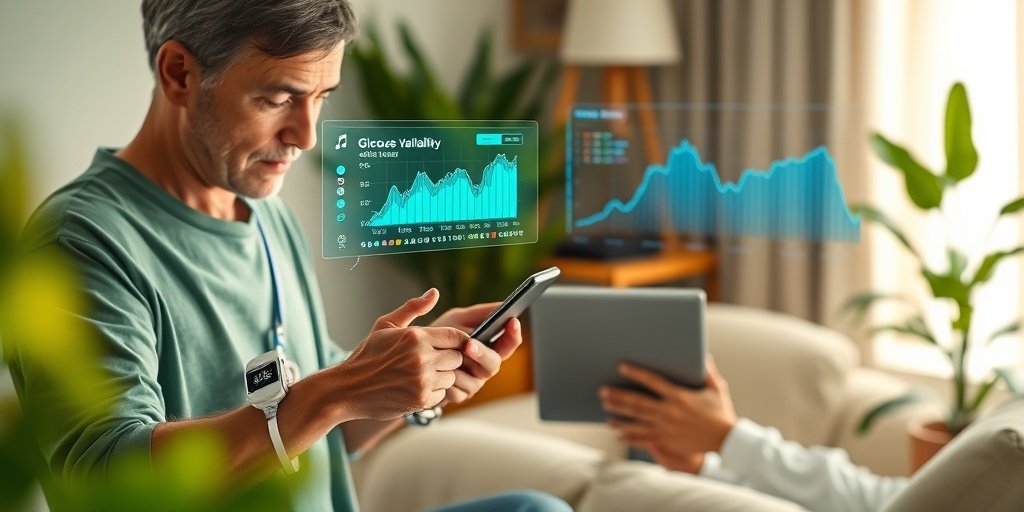⚡ Quick Summary
This article discusses the integration of AI and personalized care in diabetes management, highlighting the importance of Continuous Glucose Monitoring (CGM) and advanced metrics like Glucose Variability (GV) and Time in Range (TIR). The combination of these technologies aims to enhance glycemic control and improve patient outcomes.
🔍 Key Details
- 📊 Focus: Integration of AI in diabetes care
- 🧩 Key Metrics: Glucose Variability (GV), Time in Range (TIR)
- ⚙️ Technology: Continuous Glucose Monitoring (CGM) and AI
- 🏆 Innovations: Transcutaneous auricular vagus nerve stimulation (taVNS) combined with AI
🔑 Key Takeaways
- 🌍 Diabetes is a global health crisis with increasing incidence and economic burden.
- 📈 Traditional markers like HbA1c are inadequate for capturing short-term glycemic fluctuations.
- 🤖 AI integration provides real-time data analytics for personalized treatment plans.
- 💡 Empowering patients through AI-driven self-management is essential for sustainable improvements.
- ⚖️ Future challenges include data privacy, algorithmic bias, and equity in AI-driven care.
- 🏥 The study emphasizes the need for integrating innovations into healthcare systems.

📚 Background
Diabetes has emerged as a significant global health crisis, characterized by rising incidence, mortality, and economic burden. Traditional methods of monitoring diabetes, such as measuring HbA1c levels, often fall short in capturing the short-term glycemic fluctuations that can significantly impact patient health. This gap has led to the exploration of more precise metrics like Glucose Variability (GV) and Time in Range (TIR), which are essential for effective diabetes management.
🗒️ Study
The study highlights the integration of Continuous Glucose Monitoring (CGM) and artificial intelligence (AI) in diabetes care. By utilizing real-time data analytics, healthcare providers can develop personalized treatment plans that enhance glycemic control and reduce complications. Additionally, the combination of transcutaneous auricular vagus nerve stimulation (taVNS) with AI presents a novel approach to optimizing glucose regulation and addressing comorbidities associated with diabetes.
📈 Results
The integration of AI and CGM technologies has shown promising results in improving glycemic control. By focusing on metrics such as Glucose Variability (GV) and Time in Range (TIR), patients can achieve better management of their diabetes, leading to a reduction in complications and improved quality of life. The study emphasizes the importance of real-time data analytics in creating effective, personalized treatment plans.
🌍 Impact and Implications
The implications of this study are profound. By empowering patients through AI-driven self-management and community support, we can foster sustainable improvements in diabetes care. However, it is crucial to address challenges such as data privacy, algorithmic bias, and device interoperability to ensure equitable access to these innovations. The future of diabetes care lies in the successful integration of these technologies into healthcare systems, ultimately improving patient outcomes and enhancing quality of life.
🔮 Conclusion
This article underscores the transformative potential of integrating AI and personalized care in diabetes management. By leveraging advanced technologies like CGM and focusing on critical metrics such as GV and TIR, healthcare professionals can significantly enhance glycemic control and patient outcomes. As we move forward, it is essential to continue exploring these innovations while addressing the challenges that accompany them, paving the way for a brighter future in diabetes care.
💬 Your comments
What are your thoughts on the integration of AI in diabetes management? We would love to hear your insights! 💬 Leave your comments below or connect with us on social media:
Future horizons in diabetes: integrating AI and personalized care.
Abstract
Diabetes is a global health crisis with rising incidence, mortality, and economic burden. Traditional markers like HbA1c are insufficient for capturing short-term glycemic fluctuations, leading to the need for more precise metrics such as Glucose Variability (GV) and Time in Range (TIR). Continuous Glucose Monitoring (CGM) and AI integration offer real-time data analytics and personalized treatment plans, enhancing glycemic control and reducing complications. The combination of transcutaneous auricular vagus nerve stimulation (taVNS) with artificial Intelligence (AI) further optimizes glucose regulation and addresses comorbidities. Empowering patients through AI-driven self-management and community support is crucial for sustainable improvements. Future horizons in diabetes care must focus on overcoming challenges in data privacy, algorithmic bias, device interoperability, and equity in AI-driven care while integrating these innovations into healthcare systems to improve patient outcomes and quality of life.
Author: [‘Zhang K’, ‘Qi Y’, ‘Wang W’, ‘Tian X’, ‘Wang J’, ‘Xu L’, ‘Zhai X’]
Journal: Front Endocrinol (Lausanne)
Citation: Zhang K, et al. Future horizons in diabetes: integrating AI and personalized care. Future horizons in diabetes: integrating AI and personalized care. 2025; 16:1583227. doi: 10.3389/fendo.2025.1583227